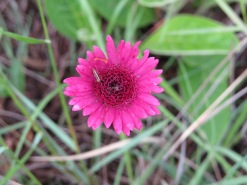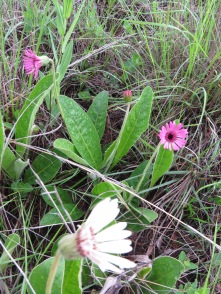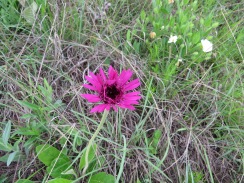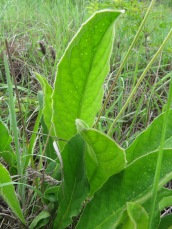 Most of the bright pink Gerbera flowers are over now, but I had taken all the pictures I needed for this blog in the last two weeks of November 2016. But as this has been a very busy time, I am only getting to research and write up about this flower today. Their main flowering time is from September through to December, but flowers may be found throughout the year in certain areas.
Most of the bright pink Gerbera flowers are over now, but I had taken all the pictures I needed for this blog in the last two weeks of November 2016. But as this has been a very busy time, I am only getting to research and write up about this flower today. Their main flowering time is from September through to December, but flowers may be found throughout the year in certain areas.
 The Pink Gerbera is widespread in KwaZulu-Natal, Mpumalanga and Swaziland where it grows in stony soil in grassland, savannah and on mountain slopes. The grassland on the south western slope of HeatherTon is where I find most of the wild flowers that I write about. These plants require a moderate to high rainfall, but may also grow in fairly damp areas as well.
The Pink Gerbera is widespread in KwaZulu-Natal, Mpumalanga and Swaziland where it grows in stony soil in grassland, savannah and on mountain slopes. The grassland on the south western slope of HeatherTon is where I find most of the wild flowers that I write about. These plants require a moderate to high rainfall, but may also grow in fairly damp areas as well.
I discussed the origin of the species name Gerbera in my blog on Gerbera ambigua, howerver the epithet, viridifolia refers to the fact that this species has green leaves which helps to separate it from the ambigua species which has white felting on the back of the leaves. Although the species varies in colour from pale to deep pink, most of the flowers I found were a very deep pink and made a beautiful splash of colour in green veld. The Gerbera species is part of the daisy family (Asteraceae) which is one of the largest plant families both in Southern Africa and in the world. To accommodate the larger botanical families, there is a further division in the taxonomy called a Tribe before we get to the Genus level. Gerberas belong to the Mutisieae tribe. Family names generally end in the suffix aceae with a few exceptions, while Tribe names tend to have the suffix eae.
 The flowerheads vary in size from 25 – 40mm in diameter and the inflorescence stalks grow about 350-450mm tall. While the daisy family flower structure can be extremely complex, a simplified explanation and diagram can be found at: http://blogs.helsinki.fi/gerberalab/research/gerbera-inflorescence-flower-types/ . The fruit from this plant is known as cypsela and is about 6mm long with a flattened pappus (a hairy parachute-like appendage).
The flowerheads vary in size from 25 – 40mm in diameter and the inflorescence stalks grow about 350-450mm tall. While the daisy family flower structure can be extremely complex, a simplified explanation and diagram can be found at: http://blogs.helsinki.fi/gerberalab/research/gerbera-inflorescence-flower-types/ . The fruit from this plant is known as cypsela and is about 6mm long with a flattened pappus (a hairy parachute-like appendage).
 The leaves are bright green, and form a rosette at the base of the plant. The elliptical leaves are petiolate and may be sparsely hairy to hairless. The leaves are greatly variable in size from 200 – 300 mm long and 10mm wide at the base to 100 – 120mm wide. One of the other identifying characteristics of this species is that it has thong-like fleshy roots.
The leaves are bright green, and form a rosette at the base of the plant. The elliptical leaves are petiolate and may be sparsely hairy to hairless. The leaves are greatly variable in size from 200 – 300 mm long and 10mm wide at the base to 100 – 120mm wide. One of the other identifying characteristics of this species is that it has thong-like fleshy roots.
 A little whimsy – Fidget Reedtree
A little whimsy – Fidget Reedtree
She plays reed pipes and sings spellbinding songs. She lives in rotting woodlands near poisonous toadstools. She can only be seen when the first leaves fall from the trees. She wears red with white spots, like toadstools and has deep green butterfly wings.






You must be logged in to post a comment.